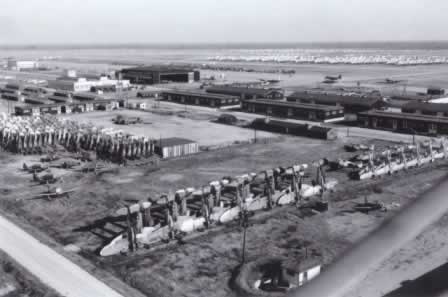Airplane Boneyards and Airliner Storage
|
Military airplanes and commercial airliners have limited lifespans. Ultimately, the planes must be retired from service, stored in "airplane boneyards" or graveyards, and finally dismantled and scrapped.
Military Aircraft Boneyards After World War II
Once peace was assured in August of 1945 and WWII ended, the military found itself with a huge surplus of old airplanes. The United States had manufactured about 294,000 aircraft for the war effort.
A large number of planes on flying status had to be ferried back to the U.S. and dealt with.
 Fighter plane boneyard at Walnut Ridge AAF, Arkansas, post WWII |
The Reconstruction Finance Corporation (RFC) established depots to store and sell surplus aircraft. At least 30 sales-storage depots and 23 sales centers, or "aircraft boneyards", were opened, and by November 1945 a total of 117,210 airplanes had been designated as surplus.
If a plane was not sold at boneyards such as those at Kingman AAF, Cal-Aero Field, and Walnut Ridge AAF, aircraft were stripped of classified information, sliced up with guillotines, and melted in smelters into ingots. The military airplane boneyard at Davis-Monthan AFB in Tucson remains active today (see below).
Active Airliner Boneyards and Storage Facilities
 Jetliners in storage at the Goodyear Airport in the Arizona desert (Staff Photo) |
Commercial airliners eventually reach end-of-life due to airframe wear and/or obsolescence. Some jetliners are temporarily taken off flying status, and must be stored in a environment that is conducive to preservation. Others are kept for spare parts for flying aircraft.
To protect airliners during their storage from wind and sun damage, engines and windows are tightly covered with white, reflective materials. A sealed airliner can thus be stored safely, for years, until the time comes to return it to active duty, or salvage. Eventually, all airliners are removed permanently from service and must be "disposed" of.
Airliner "boneyards" in the deserts of the western United States serve several functions: temporary storage, maintenance, parts reclamation, and scrapping.
Major boneyards and storage facilities are also located in Spain, France, the U.K., Australia and other countries around the world.
British Airways Airbus A380s in storage at the Chateauroux Airport - June 17, 2020 (Photo by DELEHELLE Eric) |
 |
AMARG at Davis-Monthan Air Force Base in Tucson
With the area's low humidity and hard, alkaline soil, which allows the aircraft to be naturally preserved for cannibalization or possible reuse, Davis-Monthan AFB became a major storage facility for thousands of surplus airplanes after World War II.
|
Today, as Air Force, Navy and Marine planes become obsolete and need to be disposed of, or saved for future return to service, they are stored in the Arizona desert. The storage facility is operated by the Air Force Materiel Command's 309th Aerospace Maintenance and Regeneration Group (AMARG) at Davis-Monthan Air Force Base in Tucson. It was previously known as AMARC.
It is the sole aircraft boneyard for all excess military and government aircraft. AMARG's typical inventory comprises more than 4,400 aircraft, which makes it the largest aircraft storage and preservation facility in the world.
C-5 Galaxy in storage at Davis-Monthan AFB AMARG facility (Staff Photo) |
 |



